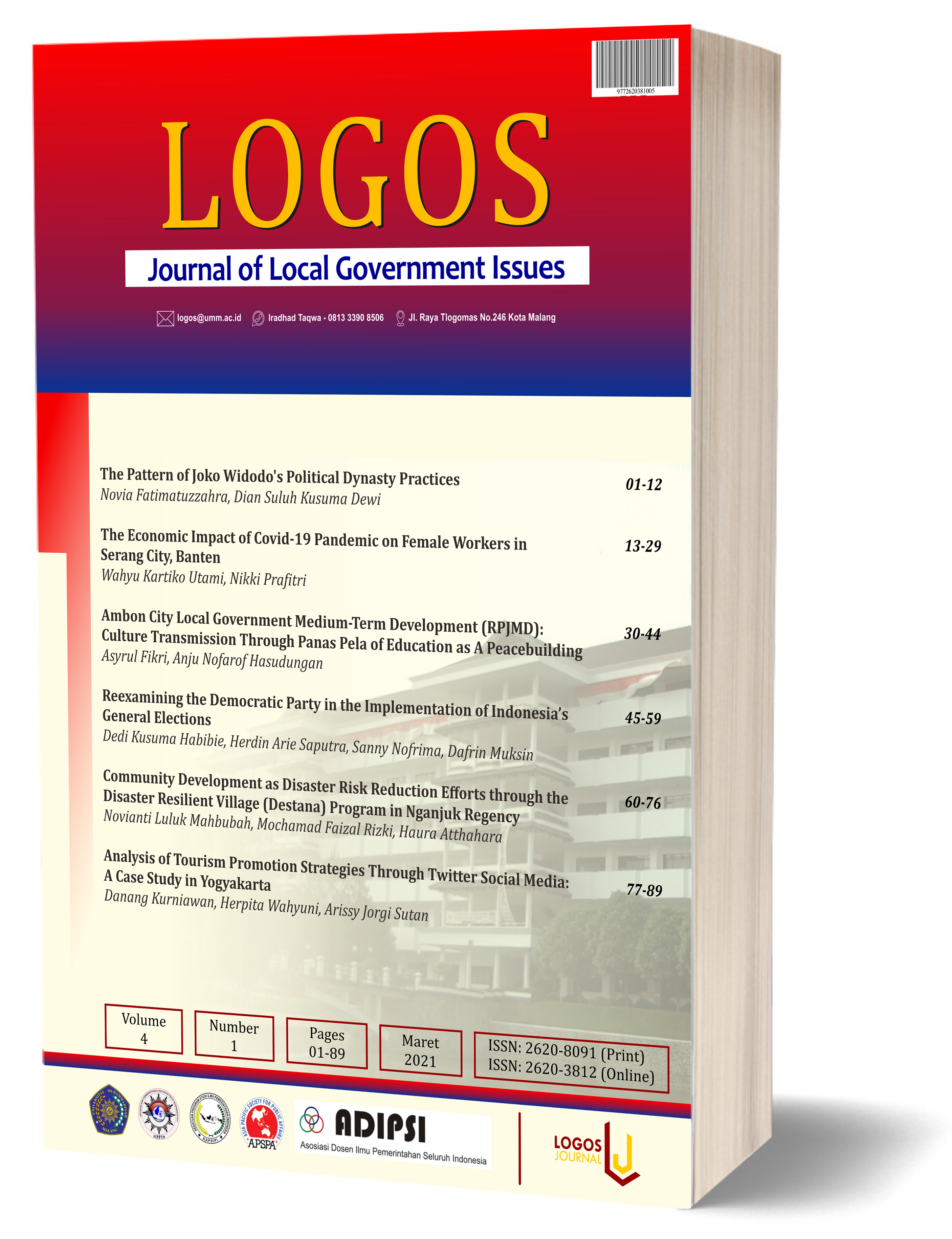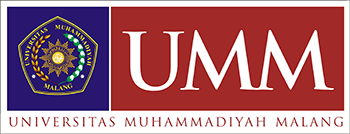Analysis of Tourism Promotion Strategies Through Twitter Social Media: A Case Study in Yogyakarta
DOI:
https://doi.org/10.22219/logos.v4i1.14732Abstract
Social media helps deliver information efficiently, Yogyakarta Government used social media to provide information on Yogyakarta’s tourism to society, mainly the local or foreign tourists. This research aims to see the strategy of delivering news of the City of Yogyakarta government to promote the tourism destination during the covid-19 pandemic transition period, using social media account @Jogja/Yogyakarta of City of Yogyakarta government in Twitter. This research used the qualitative approach with application-based used, or (Qualitative Data Analysis Software) the software used in this research is NVivo 12 plus. In the part of the analysis used NVivo 12 Plus, begin with: (1) capture the data, (2) Import the information, (3) Coding the data, (4) Classification the data, and (5) Display the data. This research shows that to promote tourism in Yogyakarta City applied with the integrated and consistent, after the Phenomena of Ciovid-19. Strategy to deliver the information focused on attracting the tourist to visit with applied the health protocol strictly, so that cerate the new culture that aims to reduce the spread of Covid-19, by limiting capacity, using Jogja Smart Service in monitoring the number of visitors.
Downloads
References
Almeida, F., & Silva, O. (2020). The Impact of COVID-19 on Tourism Sustainability: Evidence from Portugal. Advances in Hospitality and Tourism Research (AHTR), 8(2), 440-446. https://www.researchgate.net/deref/http%3A%2F%2Fdx.doi.org%2F10.30519%2Fahtr.775340.
Bakti, I. (2018). Pelatihan Komunikasi Pariwisata Berbasis Media Sosial (Instangram) di Kabupaten Pangandaran. Jurnal Pengabdian Kepada Masyarakat, 2(12), 1003-1006.
Belch, G. E., & Belch, M. A. (2004). Advertising and Promotion: An integrated Marketing Communications Perspective 6th. New York: McGraw-Hill.
Estaswara, H. (2008). Think IMC: Efektivitas Komunikasi untuk Meningkatkan Loyalitas Merek dan Laba Perusahaan. Jakarta: Gramedia Putaka Utama.
Fu, Y.-K. (2020). The Impact and Recovering Strategies of the Covid-19 Pandemic: Lessons from Taiwan’s Hospitality Industry. Cogent Social Sciences, 6(1), 1829806. https://doi.org/10.1080/23311886.2020.1829806
Gössling, S., Scott, D., & Hall, C. M. (2020). Pandemics, Tourism and Global Change: a rapid assessment of COVID-19. Journal of Sustainable Tourism, 29(1), 1-20. https://doi.org/10.1080/09669582.2020.1758708
Griffin, R. W. (2004). Manajemen. Jakarta: Erlangga.
Gunn, C. A., & Var, T. (2002). Tourism Planning: Basics, Concepts, Cases. London: Routledge.
Herdiana, D. (2020). Rekomendasi Kebijakan Pemulihan Pariwisata Pasca Wabah Corona Virus Disease 2019 (Covid-19) di Kota Bandung. Jurnal Master Pariwisata (JUMPA), 7 (1) 1-30. https://doi.org/10.24843/JUMPA.2020.v07.i01.p01
Iswandi, A. M. (2010). Analisa Komunikasi Corporate Social Responsibility (CSR) Dalam Membangun Reputasi Perusahaan (Studi Kasus: Kampanye Lifebuoy Berbagi Sehat). Tesis: Universitas Indonesia.
Jacobson, E., Degener, S., & Purcell-Gates, V. (2003). Creating Authentic Materials and Activities for the Adult Literacy Classroom: A Handbook for Practitioners. https://www.researchgate.net/publication/234717345_Creating_Authentic_Materials_and_Activities_for_the_Adult_Literacy_Classroom_A_Handbook_for_Practitioners
Khasanah, N. (2020). Upaya Pemulihan UMKM di Masa Pandemi Covid-19 Melalui Pelatihan pada Pengrajin Anyaman Pandan. JCSE: Journal of Community Service and Empowerment, 1(1), 26-29. Retrieved from http://journal.stieputrabangsa.ac.id/index.php/jcse/article/view/674
Lestari, P., & Saifuddin, M. (2020). Implementasi Strategi Promosi Produk Dalam Proses Keputusan Pembelian Melalui Digital Marketing Saat Pandemi Covid'19. Manova (Jurnal Manajemen dan Inovasi), 2(2), 23-31. https://doi.org/10.15642/manova.v3i2.301
Lionardo, A., Kurniawan, R., & Nasirin, C. (2020). Local Government Income Revenue: A Brief Study of the Policy Impact of Pandemic Covid-19 on Tourism Recovery. Proceedings of the 5th NA International Conference on Industrial Engineering and Operations Management Detroit, Michigan, USA, August 10 - 14, 2020, 2164-2168.
Mistriani, N., Maria, A. D., & Damayanti, V. (2020). Pentingnya Pelaku Industri Pariwisata Dibekali Uji Kompetensi Lewat Daring untuk Meningkatkan SDM Pariwisata di Indonesia. EDUTOURISM Journal Of Tourism Research, 2(01), 32-42. http://dx.doi.org/10.46964/jtr..v2i1.325
Morrisan, M. (2015). Periklanan Komunikasi Pemasaran Terpadu. Jakarta: Kencana.
Post, T. J. (2020). Yogyakarta welcomes 1.7 million tourists in five months amid pandemic, https://www.thejakartapost.com/travel/2020/11/29/yogyakarta-welcomes-1-7-million-tourists-in-five-months-amid-pandemic.html.
Sánchez-Teba, E. M., García-Mestanza, J., & Rodríguez-Fernández, M. (2020). The Application of the Inbound Marketing Strategy on Costa del Sol Planning & Tourism Board. Lessons for Post-COVID-19 Revival. Sustainability, 12(23), 9926. https://doi.org/10.3390/su12239926
Shimp, T. (2003). Periklanan Promosi & Aspek Tambahan Komunikasi Pemasaran Terpadu, Jilid I ( edisi 5). Jakarta: Erlangga.
Soehardi, S., Permatasari, D. A., & Sihite, J. (2020). Pengaruh Pandemik Covid-19 Terhadap Pendapatan Tempat Wisata dan Kinerja Karyawan Pariwisata di Jakarta. Jurnal Kajian Ilmiah, 1(1), 1-14. https://doi.org/10.31599/jki.v1i1.216
Surijah, E. A., Kirana, C. T., Wahyuni, N. P. J. D., Yudi, P. C., & Astini, N. K. B. (2017). Membedah Instagram: Analisis Isi Media Sosial Pariwisata Bali. Intuisi: Jurnal Psikologi Ilmiah, 9(1), 1-17. https://doi.org/10.15294/intuisi.v9i1.9560
Trihayuningtyas, E., Wulandari, W., Adriani, Y., & Sarasvati, S. (2018). Media sosial sebagai sarana informasi dan promosi pariwisata bagi generasi Z di Kabupaten Garut. Tourism Scientific Journal, 4(1), 1-22. https://doi.org/10.32659/tsj.v4i1.46
Umami, Z. (2015). Social strategy pada media sosial untuk promosi pariwisata Daerah Istimewa Yogyakarta. Interaksi: Jurnal Ilmu Komunikasi, 4(2), 195-201. https://doi.org/10.14710/interaksi.4.2.195-201
Wachyuni, S. S., & Kusumaningrum, D. A. (2020). The Effect of COVID-19 Pandemic: How are the Future Tourist Behavior? Journal of Education, Society and Behavioural Science, 33 (4) 67-76. https://doi.org/10.9734/jesbs/2020/v33i430219
Yananda, M. R., & Salamah, U. (2014). Branding tempat: membangun kota, kabupaten, dan provinsi berbasis identitas. Jakarta: Makna Informasi.
Downloads
Published
How to Cite
Issue
Section
License
Copyright (c) 2021 Danang Kurniawan, Herpita Wahyuni, Arissy Jorgi Sutan

This work is licensed under a Creative Commons Attribution-ShareAlike 4.0 International License.
Authors who publish with this journal agree to the following terms:
- Authors retain copyright and grant the journal right of first publication with the work simultaneously licensed under a Creative Commons Attribution-ShareAlike 4.0 International License. that allows others to share the work with an acknowledgment of the work's authorship and initial publication in this journal.
- Authors are able to enter into separate, additional contractual arrangements for the non-exclusive distribution of the journal's published version of the work (e.g., post it to an institutional repository or publish it in a book), with an acknowledgment of its initial publication in this journal.
- Authors are permitted and encouraged to post their work online (e.g., in institutional repositories or on their website) prior to and during the submission process, as it can lead to productive exchanges, as well as earlier and greater citation of published work (See The Effect of Open Access).

This work is licensed under a Creative Commons Attribution-ShareAlike 4.0 International License.













